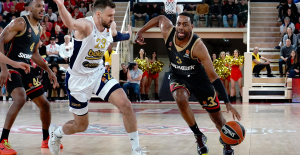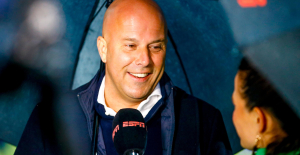For almost 56 hours everything had gone well. Apollo 13, the third lunar landing mission, has been on track since liftoff at 2:13 p.m. local time on April 11, 1970 at Cape Canaveral, Florida. That changed abruptly – on April 13 at 10:07 p.m. Florida local time.
According to the detailed Nasa overview, the spacecraft was violently shaken exactly 55 hours, 54 minutes and 53.182 seconds after the start. In the technical language of the engineers, this was called "Sudden accelerometer activity on X, Y, Z axes" - i.e. "sudden activity of the acceleration sensors in all three axes". In simpler terms, Apollo 13 shook violently.
It was six seconds before any of the three men on board pressed the "master" alarm button. That shows how surprised the astronauts Jim Lovell, Jack Swigert and Fred Haise were - after all, all three had years of experience as jet and test pilots, so they were used to lightning decisions.
Another 21 seconds later, Swigert was the first to pass on information to NASA's flight control center in the US state of Texas: "Okay, Houston, we've had a problem here." He literally said: "Houston, we've had a problem here ', which is usually translated as 'Houston, we have a problem'.
Astronaut Jack Lousma, who was in Houston in direct contact with Apollo 13 (this task was always performed at NASA by an astronaut who had undergone the same training as the men in space), responded immediately. Given the distance of around 330,000 kilometers between Earth and spacecraft, however, his question was delayed by a few seconds: "This is Houston. Say again please." ("This is Houston. Please repeat.")
As a result, Jim Lovell, the commander of Apollo 13, repeated the legendary words: "Houston, we have a problem."
What happened? What did the bang mean for the three men in the command module, which of all things bore the name "Odyssey"? At first, Lovell, Swigert and Haise only saw what the consequences were: the voltage of one of the two main batteries dropped to zero, and two of the three fuel cells had failed. This meant that there would soon no longer be any water that these components supplied alongside energy.
"The worst moment was probably," Lovell recalled, "when we saw oxygen glistening out of the window into space." The instruments said: Oxygen tank #2 was empty. No. 1 was ailing and seemed to be out in the medium term. Apollo 13's supply module, on the top of which the astronauts' capsule was attached, was apparently badly damaged.
It was immediately clear to everyone involved, the three crew members as well as the team in Houston: There would be no moon landing during this mission. Rather, the question was: Would Lovell, Swigert, and Haise return to Earth alive?
A decision had to be made: should the flight be canceled immediately? To do this, one would have to ignite the control engines of the supply module. But no one could say whether the entire spacecraft (including the lunar module "Aquarius", coupled upside down to the front of the "Odyssey") would not explode.
So there was only one other option: continue flying to the moon and gain momentum in its gravitational field for the way back. For Lovell, Swigert and Haise, however, this meant another 90 hours of travel in acute danger.
The three astronauts also had to improvise. Although the Apollo program had installed all vital systems at least three times, sometimes even four times, that was suddenly no longer enough. For them, therefore, the landing module became a lifeboat.
The construction, designed for two men, could not return to earth due to the lack of a heat shield. But the astronauts were able to retreat there on the return flight and shut down the command module until they were back in Earth orbit.
The three and a half days became a challenge: The Aquarius' heating was switched off to save energy; the temperature dropped to three degrees. Each was given only a small sip of water per day and their astronaut food could not be reheated.
Worse was the air filter problem: "Aquarius" was designed for two people and a maximum of 72 hours of use. Now three men were breathing in it, for the foreseeable future of more than 80 hours: the carbon dioxide content of the air was rising far too quickly.
But the filters of the "Odyssey", which were of course sufficiently dimensioned, did not match the ventilation system of the "Aquarius". Half a dozen Houston engineers then improvised how to make an adapter with the resources available on Apollo 13.
Lovell, Swigert and Haise managed to do this, as did the recommissioning of the command module "Odyssey" on April 17, 1970 and the manual course correction for re-entry into the earth's atmosphere. Shortly before, the three astronauts blew up the "Aquarius" and the supply module.
Only then did they realize what a huge hole the explosion had torn. Jim Lovell recorded the damage. These photos later made it possible to determine the cause of the near-disaster: a roasted line that led to the short circuit – always extremely dangerous in the vicinity of highly reactive pure oxygen.
That the three astronauts still managed to get back to earth alive was a minor miracle. "Apollo 13 was the most successful failure that space travel has ever experienced," says Ulli Kulke. The science journalist and expert on the lunar program aptly calls this mission "a living fairy tale".
You can also find "World History" on Facebook. We are happy about a like.
This article was first published in April 2020.

 B:SM will break its investment record this year with 62 million euros
B:SM will break its investment record this year with 62 million euros War in Ukraine: when kyiv attacks Russia with inflatable balloons loaded with explosives
War in Ukraine: when kyiv attacks Russia with inflatable balloons loaded with explosives United States: divided on the question of presidential immunity, the Supreme Court offers respite to Trump
United States: divided on the question of presidential immunity, the Supreme Court offers respite to Trump Maurizio Molinari: “the Scurati affair, a European injury”
Maurizio Molinari: “the Scurati affair, a European injury” First three cases of “native” cholera confirmed in Mayotte
First three cases of “native” cholera confirmed in Mayotte Meningitis: compulsory vaccination for babies will be extended in 2025
Meningitis: compulsory vaccination for babies will be extended in 2025 Spain is the country in the European Union with the most overqualified workers for their jobs
Spain is the country in the European Union with the most overqualified workers for their jobs Parvovirus alert, the “fifth disease” of children which has already caused the death of five babies in 2024
Parvovirus alert, the “fifth disease” of children which has already caused the death of five babies in 2024 Inflation rebounds in March in the United States, a few days before the Fed meeting
Inflation rebounds in March in the United States, a few days before the Fed meeting Video games: Blizzard cancels Blizzcon 2024, its annual high mass
Video games: Blizzard cancels Blizzcon 2024, its annual high mass Falling wings of the Moulin Rouge: who will pay for the repairs?
Falling wings of the Moulin Rouge: who will pay for the repairs? “You don’t sell a company like that”: Roland Lescure “annoyed” by the prospect of a sale of Biogaran
“You don’t sell a company like that”: Roland Lescure “annoyed” by the prospect of a sale of Biogaran Exhibition: in Deauville, Zao Wou-Ki, beauty in all things
Exhibition: in Deauville, Zao Wou-Ki, beauty in all things Dak’art, the most important biennial of African art, postponed due to lack of funding
Dak’art, the most important biennial of African art, postponed due to lack of funding In Deadpool and Wolverine, Ryan and Hugh Jackman explore the depths of the Marvel multiverse
In Deadpool and Wolverine, Ryan and Hugh Jackman explore the depths of the Marvel multiverse Tom Cruise returns to Paris for the filming of Mission Impossible 8
Tom Cruise returns to Paris for the filming of Mission Impossible 8 Skoda Kodiaq 2024: a 'beast' plug-in hybrid SUV
Skoda Kodiaq 2024: a 'beast' plug-in hybrid SUV Tesla launches a new Model Y with 600 km of autonomy at a "more accessible price"
Tesla launches a new Model Y with 600 km of autonomy at a "more accessible price" The 10 best-selling cars in March 2024 in Spain: sales fall due to Easter
The 10 best-selling cars in March 2024 in Spain: sales fall due to Easter A private jet company buys more than 100 flying cars
A private jet company buys more than 100 flying cars This is how housing prices have changed in Spain in the last decade
This is how housing prices have changed in Spain in the last decade The home mortgage firm drops 10% in January and interest soars to 3.46%
The home mortgage firm drops 10% in January and interest soars to 3.46% The jewel of the Rocío de Nagüeles urbanization: a dream villa in Marbella
The jewel of the Rocío de Nagüeles urbanization: a dream villa in Marbella Rental prices grow by 7.3% in February: where does it go up and where does it go down?
Rental prices grow by 7.3% in February: where does it go up and where does it go down? Even on a mission for NATO, the Charles-de-Gaulle remains under French control, Lecornu responds to Mélenchon
Even on a mission for NATO, the Charles-de-Gaulle remains under French control, Lecornu responds to Mélenchon “Deadly Europe”, “economic decline”, immigration… What to remember from Emmanuel Macron’s speech at the Sorbonne
“Deadly Europe”, “economic decline”, immigration… What to remember from Emmanuel Macron’s speech at the Sorbonne Sale of Biogaran: The Republicans write to Emmanuel Macron
Sale of Biogaran: The Republicans write to Emmanuel Macron Europeans: “All those who claim that we don’t need Europe are liars”, criticizes Bayrou
Europeans: “All those who claim that we don’t need Europe are liars”, criticizes Bayrou These French cities that will boycott the World Cup in Qatar
These French cities that will boycott the World Cup in Qatar Euroleague: at the end of the suspense, Monaco equalizes against Fenerbahçe
Euroleague: at the end of the suspense, Monaco equalizes against Fenerbahçe Women's Six Nations: Where to see and five things to know about France-England
Women's Six Nations: Where to see and five things to know about France-England Liverpool: it is confirmed, Slot will succeed Klopp on the Reds bench
Liverpool: it is confirmed, Slot will succeed Klopp on the Reds bench Ligue 1: Montpellier and Nantes back to back, two reds in stoppage time
Ligue 1: Montpellier and Nantes back to back, two reds in stoppage time


















